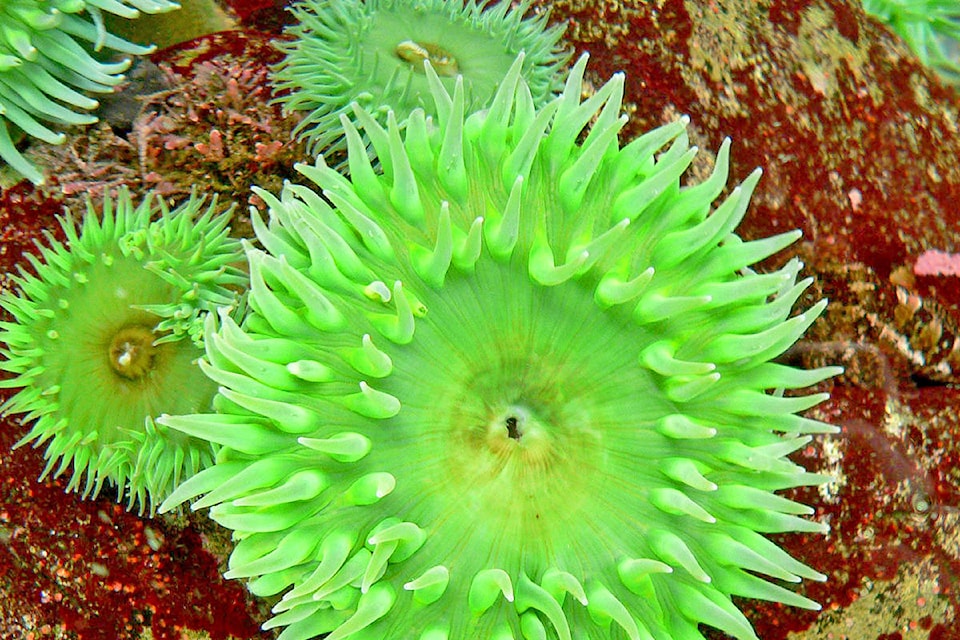Sarah DICKENS
Special to the Tribune
June 8 marked World Oceans Day — a day to remember the big, blue part of our planet, and do what we can to help protect its health.
The day is used to celebrate and to take steps to raise awareness about how we can practically contribute to a lasting future for our oceans.
At the Scout Island Nature Centre, we have a plethora of colourful creatures from the intertidal zone of Vancouver Island.
Within the tank are 30 species of plants and animals that dwell within cold, clean, moving salt water.
We want to celebrate by introducing you to a few of our favourite sea creatures and some of the qualities that make them unique and worth taking care of.
ROSE STAR
Pictured is our lovely rose star. She is a kind of sea star that can be found in a variety of low-current habitats.
Rose stars are often found in rocky areas, and inhabit the low, intertidal and subtidal areas to about 1,200 metres.
They can be found from the Arctic to northern Washington, as well as south to Japan and China, New Jersey and Britain.
This cool sea star gets its name from the red, pink or purple radiating rings of colour on its back.
A female sea star can release more than 2,000 eggs at a time.
They are also relatively fast for a sea star and came move about 70 centimetres per minute.
DUNGENESS CRAB
Next is our Dungeness Crab: an incredibly aggressive eater and could eat krill all day, every day, until Scout Island ran out.
They are a widely distributed crab and prefer to dwell in eelgrass beds and sandy or muddy areas.
The Dungeness Crab often can blend into its surroundings so well that it is undetected and, if in danger, it will try to bury their entire bodies under sand.
GIANT GREEN ANEMONES
Besides residing in the tank at Scout Island, Giant Green Anemones are found in tide pools and intertidal/subtidal zones along rocky shores, at depths of up to 15 metres.
They are found along the west coast of North and Central America, along Hudson Bay in Canada and eastern coast of Russia.
A fun fact about these organisms is that their disk and tentacles colour (either green, blue or white) changes depending on how much sunlight the anemone receives.
This is because the anemone has a symbiotic relationship with algae living inside its tissues, so when sunlight is plentiful, the algae grows and produces a bright green colour.
The staff at Scout Island diligently care for their tank of sea creatures, and want people in the community to recognize the ocean for the beautiful and vital part of the Earth that it is.
Not only does the ocean provide most of the oxygen that we breathe, but it sequesters a third of the carbon dioxide that humans produce.
It also is a critical source of food and medicine for the world.
CAN I STILL CELEBRATE WORLD OCEANS DAY?
Look online for different talks, film screenings and petitions that you can easily sign up for.
Or, you could make your own celebratory event at home by watching a movie about the ocean.
You could also take a walk at Scout Island.
Even if you can’t see the ocean from here, breathe deep and appreciate how the sea provides oxygen for your lungs to enjoy, and know that the water you are looking at will be at the Pacific Ocean in about five weeks.
Cutting down on plastic is another option.
Pollution is one of the biggest threats to the ocean.
Try using reusable containers instead of single-use items like straws, plastic forks, bags, etc.
WHAT’S THE POINT AGAIN?
The point is that it’s important to recognize how the world is interconnected — how we choose to treat our Earth does make a difference.
Reflect on all that the ocean contributes to your every day life, and be inspired to work for a healthier and more beautiful ocean in the future.
Sarah Dickens is a teacher naturalist at Scout Island Nature Centre.
